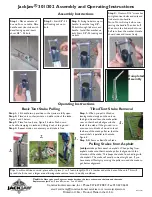
13
Subject to change without notice
Operating modes of the vertical amplifi er
The controls most important for the vertical amplifi er are: VERT/
XY
32
, CH 1
31
, CH 2
33
– and in digital mode also – LC/AUX
36
.
They give access to the menus containing the operating modes
and the parameters of the individual channels.
Changing the operating mode is described in the chapter:
”Controls and Readout“.
Remark: Any reference to ”both channels“ always refers to
channels 1 and 2.
Usually oscilloscopes are used in the Yt mode. In analog mode
the amplitude of the measuring signal will defl ect the trace
vertically while a time base will defl ect it from left to right.
The vertical amplifi ers offer these modes:
– One signal only with CH1.
– One signal only with CH2.
− Two signals with channels 1 and 2 (DUAL trace mode).
− Two signals displayed as one in addition (ADD) mode.
In digital mode the Option HO2010 additionally enables the logic
state display of 4 logic channels (LC0 ... LC3).
In DUAL mode both channels are operative. In analog mode
the method of signal display is governed by the time base (see
also ”Controls and Readout“). Channel switching may either
take place after each sweep (alternate) or during sweeps with
a high frequency (chopped).
The normal choice is alternate, however, at slow time base set-
tings the channel switching will become visible and disturbing,
when this occurs select the chopped mode in order to achieve
a stable quiet display.
In digital mode no channel switching is necessary as each input
has its own A/D converter, signal acquisition is simultaneous.
In ADD mode the two channels 1 and 2 are algebraically ad-
ded (±CH1 ±CH2). With + polarity the channel is normal, with
– polarity inverted. If + Ch1 and – CH2 are selected the difference
will be displayed or vice versa.
Same polarity input signals:
Both channels not inverted:
= sum
Both channels inverted:
= sum
Only one channel inverted:
= difference
Opposite polarity input signals:
Both channels not inverted:
= difference
Both channels inverted:
= difference
One channel inverted:
= sum.
Please note that in ADD mode both position controls will be
operative. The INVERT function will not affect positioning.
Often the difference of two signals is to be measured at signal
take-offs which are both at a high common mode potential.
While this one typical application of the difference mode one
important precaution has to be borne in mind: The oscillosco-
pe vertical amplifi ers are two separate amplifi ers and do not
constitute a true difference amplifi er with as well a high CM
rejection as a high permissible CM range! Therefore please
observe the following rule: Always look at the two signals in
the one channel only or the dual modes and make sure that
Prior to adjustment make sure that the trace rotation adjust-
ment was performed.
Connect the 10:1 probe to the input. Use DC coupling. Set the
VOLTS/DIV knob for a signal display height of 4 cm and TIME/
DIV to 0.2 ms/cm, both calibrated. Insert the probe tip into the
calibrator connector PROBE ADJ.
You should see 2 signal periods. Adjust the compensation ca-
pacitor (see the probe manual for the location) until the square
wave tops are exactly parallel to the graticule lines (see picture
1 kHz). The signal height should be 4 cm ±1.6 mm (3% oscillo-
scope and 1% probe tolerance). The rising and falling portions
of the square wave will be invisible.
1 MHz adjustment
The HAMEG probes feature additional adjustments in the
compensation box which allow to optimise their hf behaviour.
This adjustment is a precondition for achieving the maximum
bandwidth with probe and a minimum of pulse aberrations.
This adjustment requires a calibrator with a short rise time
(typ. 4 ns) and a 50 Ω output, a frequency of 1 MHz, an amplitude
of 0.2 V
pp
. The PROBE ADJ. output of the scope fulfi ls these
requirements.
Connect the probe to the scope input to which it is to be adjusted.
Select the PROBE ADJ. signal 1 MHz. Select DC coupling and
5 mV/cm with VOLTS/DIV. and 0.1 μs/cm with TIME/DIV., both
calibrated. Insert the probe tip into the calibrator output connec-
tor. The screen should show the signal, rise and fall times will
be visible. Watch the rising portion and the top left pulse corner,
consult the manual for the location of the adjustments.
The criteria for a correct adjustment are:
– short rise time, steep slope.
– clean top left corner with minimum over- or undershoot,
fl at top.
After adjustment check the amplitude which should be the
same as with 1 kHz.
It is important to fi rst adjust 1 kHz, then 1 MHz. It may be ne-
cessary to check the 1 kHz adjustment again.
Please note that the calibrator signals are not calibrated with
respect to frequency and thus must not be used to check the
time base accuracy, also their duty cycle may differ from 1:1.The
probe adjustment is completed if the pulse tops are horizontal
and the amplitude calibration is correct.
O p e r a t i n g m o d e s o f t h e v e r t i c a l a m p l i f i e r
incorrect
correct
incorrect














































